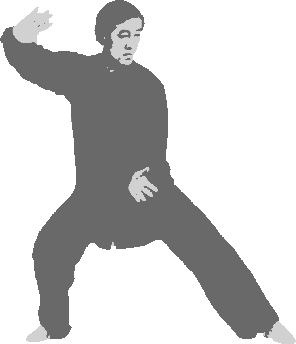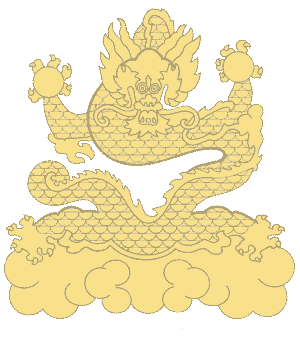Chen Zhenglei was born in May 1949 in Chenjiagou, Wenxian, Henan,
Peoples Republic of China. The son of Chen Zhaohai (who died a year
after his son was born), he has been practicing Chen style Taijiquan
for over forty years.
His teachers include the famed masters Chen Zhaopei (with whom he
lived and trained) and Chen Zhaokui (both hisuncles), masters of the
18th generation in Chenjiagou. He is known as "Taiji Jingang"-
one of the top four practitioners of his generation in Chenjiagou.
He received his degree in physical education from Henan University
in 1985. He was twice the Taijiquan Grand Champion at the National
Taijiquan Competitions, and has won over 10 gold medals at the Henan
Martial Arts Competition. In 1987 he was selected as a National Martial
Arts First Class Judge, and his team won three team first places from
1989 to 1991 at the National and Henan Martial Arts Meets.
He has trained many great athletes, among them the celebrated champion
Ding Jie. In 1995 he was awarded the title of Da Shr (Grandmaster).
Master Chen is the author of Chen Shi Taijiquan Xie Hui Zhong (A Compendum
of Taijiquan Boxing and Weapons), the first volume of which will soon
have its' first english language publication, as well as Taijiquan
Nei Qi Qian Tan Yu Jing Luo Xue Shuo ( A discussion of Internal Energy
in Taijiquan and a Study of the Main and Collateral Channels). He
is the author of an instructional videotape, Shi Chuan Chen Shi Taijiquan
Shu, and plans to release a multivolume video set dealing with Lao
jia, Xin jia, Push Hands, Weapons, and Qigong.
Master Chen is in great demand both in China and abroad as an instructor.
He has trained over 15 of the coaches for the Beijing and Wuhan Physical
Culture Institutes, and is an advisor to Taiji organizations in Japan,
France, America, and Italy.
Master Chen currently teaches in Zhengzhou City, Henan Province, PRC.
The following interview was conducted during Master Chens' first visit
to the US in August of 1996 in Fairfax, VA. Special Thanks to Sifu
Christopher Pei of the US Wushu Academy for his translation.
Q. Chen style Taijiquan is becoming more popular in the US.
What advice can you give to the person seeking a teacher of the style?
A. If you want to understand how to find a good teacher,
first you must understand what Taijiquan is all about. Most people
who seek out Chen style specifically already are interested in Taijiquan,
and have some basic knowledge about the art. A good teacher will embody
the fundamentals of the art. The most basic requirement is that when
you practice, your body is upright: your footwork is very solid and
steady, and the hips and kua is open and relaxed. Externally, the
frame looks very big and comfortable, and the movement is continuous,
without any hesitations, like running water or clouds passing in the
sky. When you seek to release energy (fa jing), it goes from inside
to outside, from the legs (or root) thru the body to finally release
in the hand. If the footwork is solid and steady, and the body is
light and natural, and, if after practicing a routine several times
in sucession one is not out of breath and drained of energy, and can
breathe normally, laugh and talk, then this is the mark of a teacher
with good skill.
Q. Due to the demands of work and family, many practitioners
of Taiji are limited in the amount of time that they can train each
day. What advice do you have for them?
A. Regardless of how busy you may be, you should
make the time to practice for at least 20 minutes each day. The most
important aspect of your practice is "heart": even if you
don't have time to practice formal exercises or routines, Taijiquan
is in your heart, always. You are always thinking about it, using
its' principles. Everything you do, working, eating, walking, it is
all a way to practice Taijiquan. If I have the time and the space,
I will practice the entire form: if I don't, I will practice just
a few movements. So, if you are at work, and it is difficult to practice
routines, perhaps you can practice by reading documents in the "pile
stance". If you are writing at a desk, don't use your chair,
stand in a low horse stance. When you feel tired in your daily doings,
apply the principles of "Feng Song", and stay loose and
relaxed.
Therefore, Taiji must be put in your heart: it must be there with
you all of the time, not just when you feel like practicing. When
we were growing up farming in the village, there was not enough time
to practice due to our work, so, when we worked, we practiced: everywhere,
all the time, in any activity. Digging with a shovel, plowing, doing
carpentry, lifting: all were done using Taiji body mechanics. In my
boyhood, all of that work was done by hand: now much of it is done
by tools and machines.
Q. In Chen Village, how is the art taught?
A. Because Chenjiagous' location is so rural, so
out of the way, there are not too many influences on the villages
culture from the outside. There is no other martial art in the village
besides Taiji. So, the children of the village, as they grow up, are
exposed to it and influenced by it because it is the only art they
see.
In the old days, they began training children at the age of about
seven years: now, they begin training as early as five or six years
of age. In the big cities, most people understand Taiji as being only
for health, meditation, and exercise. In Chenjiagou, Taiji is understood
as being foremost a martial art. So you can see there is a large difference
between the approach to training in the village and in other parts
of the country. Since this is the only martial art taught in the village,
children are started young. The schools teach it as part of their
physical education programs.
In the old days, children would begin by learning forms right away,
in the traditional manner of learning sequence, corrections to movement,
and then developing internal energy. Now, things are more sophisticated:
children begin training with flexibility exercises and chan ssu gong,
but do not begin the forms for a while. Traditionally, everyone begins
with Laojia I Lu at first. From there, they learn the single edge
sword. After training in ILu, after two years, the body is relaxed,
and the student begins learning pushing hands and Erh lu.
Q. When is a student deemed ready to learn Xin Jia?
A. First, one must be completely relaxed, and understand
the true meaning of softness. The various parts of the body must move
in a coordinated manner, for there are so many circular and spiralling
movements in Xin Jia that if the student cannot move in a coordinated
way, they cannot express the true flavor of Xin Jia at all.
Q. Do you feel it is a mistake for a student to begin their
training with Xin Jia?
A. Yes. The student doesn't understand softness and
coordination, and can't produce the flavor of the style.
Q. What are the benefits to practicing Xin Jia?
A. Xin Jia uses the body in different ways: keeping
loose, yet suddenly releasing power, the snapping nature of the movements-these
are all characteristics of the style. Xin Jia movements are more demanding
on the body than those of Lao Jia: it is better for fitness. It develops
the ability to release energy better. But if a person does not understand
the precise progression of study and the correct training methods,
it is easy to get sidetracked, and lose one's way, and make mistakes
that are difficult to correct. It is easy for the qi to rise in the
chest, and to lose ones' breath. As the saying goes, "The head
is heavy, and the legs are light". These are common mistakes
people experience.
Q. You have been practicing Taijiquan for over forty years.
Could you tell us something of your experiences and recollections
of training with Master Chen Zhaopei? (Editors note:
Chen Zhaopei (1883-1972) was a student of Chen Dengke (his father),
Chen Yanxi, Chen Pinsan, and Chen Fake. His teaching and efforts to
continue the legacy of Chenjiagou Tajiquan led to the spread of Chen
style Taiji to the world outside Chenjiagou as well as the establishment
of the Wushu Training Halls in both Chenjiagou and Wenxian.)
A. Although my teacher left us over 20 years ago,
I will keep the memory of how he taught in my heart always. Chen Zhaopei
was my uncle. I started training with him when i was eight years old.
In 1928 he went to Beijing to teach. During this period he asked Chen
Fake to come to Beijing to teach also. After Chen Fake arrived, he
travelled to Nanjing. At that time, the Kuomintang was in power, and
the mayor of Nanjing invited him to come and teach a class there.
(Editors note; at that time, he also served as an honorary coach at
the famous Central Martial Arts Institute)
From 1928 to 1958, he taught Taiji outside of the village. Some of
the cities he taught in were Beijing, Nanking, Xian, Lanzhou, Luoyang,
Kaifeng, and Zhengzhou. In 1958 he returned to the village. After
his return visit, he realised that not very many people were practicing
Taiji anymore, due to the stresses of the World War, and the war between
the Nationalists and the Communists. Seeing this, he became very worried
that the art would eventually decline. So he returned to his job at
the Yellow River Regulatory Commision (in Kaifeng) and requested an
early retirement. He returned home to the spartan life of the village
to recruit a group of children for serious training.
There were about thirty kids who would gather in front of his door
for instruction. He would lead the class in front while his wife would
be in the back, making corrections. He was very patient, and took
great pains to make corrections. He was never angry.
During these years, there were three years of "natural disasters"
(flooding, famine, etc) as well as the beginning of the cultural revolution.
During the cultural revolution, Tajiquan was considered to be old
fashioned, and part of old religions and superstitions. It was forbidden
to promote Taijiquan at this time. Also, because he was connected
to the Nationalists in Nanjing in the 1930s, he was in a lot of trouble.
during this time, if you wanted to teach or learn, it was very difficult.
(editors note: Chen Kesen, Chen Zhaopei's son, wrote of this period:
"During the cultural revolution, my father was persecuted and
subjected to public "struggle sessions", but during the
still of the night, Chen Zhenglei and several others of his prized
disciples secretly went to study under him. My father, demonstrating
that he was not afraid of the persecution, bravely carried on with
his teaching of Taijiquan.")
So, at times, he would see his students practice seriously, other
times not so seriously. I know that this made him angry, but he never
showed it to us. Instead, he would tell us stories to make us understand
why we needed to practice with determination. He told us many stories
about heroes in history whose efforts led them from obscurity to sucess.
He told us the story of the famous ancient musician who was the inventor
of the 5 tones style of Chinese music. Because he wanted so badly
to develop this music, he rubbed salt in his eyes to blind himself
and rid himself of the distractions of sight and thus could focus
his attentions on his hearing, and his music. He also told us of General
Yeuh Fei who had his mother tattoo 4 characters on his back which
read "give yourself wholeheartedly to your country".
He told us these stories because he wished us to follow in the example
of these heroes, and so that we would be resolute and tough in our
lives. Most importantly, he made us realize that we were the future
successors of the art of Taijiquan, and that we must practice continuously
to live up to this responsibility. If we did not, our generation would
break the tradition of instruction passed down from our ancestors.
Tajiquan comes from the Chen family. If we broke this tradition, we
would not be able to stand before our ancestors, and our children
would curse us. So, when we were very young, we were made to understand
our responsibility. Regardless of how difficult our situation was
at the time, we had to practice hard.
Toward the end of the cultural revolution, the Communist Party decide
to begin to promote martial arts. As a result, my teachers morale
and confidence improved. His teaching began to increase. He would
teach with great patience. If you did not understand a movement, he
would repeat it over and over for you. Not only would he explain the
movement, but he would expalin the principles behind it and the applications.
At that time, he was in his eighties, but he would still teach push
hands.
In 1972, he died. He died as a result of overwork. He took Taiji teams
all over China to compete. His living conditions were not good in
the village, and could not sustain the the energy which he expended
in teaching over those years. Before his death, he taught me all of
the principles, techniques, barehand routines, weapons and push hands
that he knew.
Chen Zhaopei has passed away, but he left a group of young people
dedicated to Taiji. Teachers of the style, whether they are from Chenjiagou
or not, all are in a way descended from him. He was the one responsible
for promoting the art when it was in decline, and rasing the next
generation of teachers in the village.
Q. What can you tell us about the state of Taijiquan in China
today?
A. In 1978, the Communist party began its open door policy. The media
began to report stories about Tajiquan, and as a result, more people
became aware of it. International exchanges began to occur, and more
people became aware of Taijiquan across the world.
In the past 5 to 6 years, the Chinese government has become more
interested in the promotion of Taijiquan. Today there are many different
Taijiquan competitions that occur in China. The government spent several
million (chinese) dollars to build a large martial arts academy in
Wenxian, near Chenjiagou.
So far, there have been four international Taiji Conferences held
there. Over 33 countries have been represented, with over 300 competitors
attending. There are over 90 international organizations which participate.
There are three separate arenas for competition. All the major styles
are represented. Events include barehand routines, weapons, demonstrations,
and push hands, including lei tai, in which the competitors meet on
raised platforms. Whoever is forced off the platform loses. The pushing
hands competition is not restricted like it is in the US: it is free
style. Other than kicking, punching, grabbing hair, biting, using
elbows, knees and head butting, "anything goes".
Q. Do you have any impressions to share with us regarding
your first visit to the US?
A. I am impressed by the cleanliness of the environment
here. Everywhere I go, everything looks so clean. And the people are
very friendly and welcoming. This has left a deep impression on me.
The students I have taught here are very hard working. Everyone has
such a strong desire to learn. This pleases me, and makes me want
to teach them more, and make their movements more correct. Hopefully
these students will help spread the seeds of Chenjiagou Taijiquan
in the US. As we say, "small sparks start a big fire".
Wherevever I travel to teach, I tell my students that although Taijiquan
was begun by the Chen family in Chenjiagou, it belongs to all of mankind.
It is my hope that people will work together to make Taiji very popular
all over the world. Hopefully, Taijiquan, one of the precious pearls
of the east, will become a tool for the benefit of everyone, regardless
of nationality.
Sources: "My Father, Chen Zhaopei" by Chen Kesen, Henan Tiyu Bao,
4/22/93.
Copyright 1999 by Herbert O. Rich.
|



